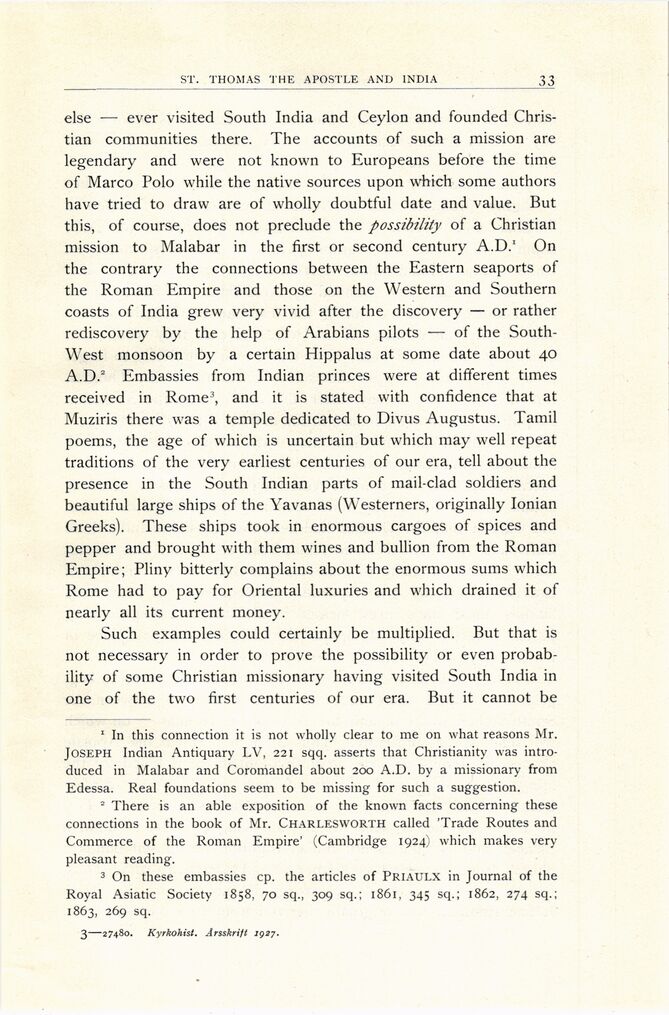
Full resolution (JPEG) - On this page / på denna sida - I. Undersökningar - Jarl Charpentier, St. Thomas the Apostle and India

<< prev. page << föreg. sida << >> nästa sida >> next page >>
Below is the raw OCR text
from the above scanned image.
Do you see an error? Proofread the page now!
Här nedan syns maskintolkade texten från faksimilbilden ovan.
Ser du något fel? Korrekturläs sidan nu!
This page has never been proofread. / Denna sida har aldrig korrekturlästs.
ST. THOMAS THE APOSTLE AND INDIA
SI
else — ever visited South India and Ceylon and founded
Christian communities there. The accounts of such a mission are
legendary and were not known to Europeans before the time
of Marco Polo while the native sources upon which some authors
have tried to draw are of wholly doubtful date and value. But
this, of course, does not preclude the possibility of a Christian
mission to Malabar in the first or second century A.D." On
the contrary the connections between the Eastern seaports of
the Roman Empire and those on the Western and Southern
coasts of India grew very vivid after the discovery — or rather
rediscovery by the help of Arabians pilots — of the
South-West monsoon by a certain Hippalus at some date about 40
A.D.2 Embassies from Indian princes were at different times
received in Rome3, and it is stated with confidence that at
Muziris there was a temple dedicated to Divus Augustus. Tamil
poems, the age of which is uncertain but which may well repeat
traditions of the very earliest centuries of our era, tell about the
presence in the South Indian parts of mail-clad soldiers and
beautiful large ships of the Yavanas (Westerners, originally Ionian
Greeks). These ships took in enormous cargoes of spices and
pepper and brought with them wines and bullion from the Roman
Empire; Pliny bitterly complains about the enormous sums which
Rome had to pay for Oriental luxuries and which drained it of
nearly all its current money.
Such examples could certainly be multiplied. But that is
not necessary in order to prove the possibility or even
probability of some Christian missionary having visited South India in
one of the two first centuries of our era. But it cannot be
1 In this connection it is not wholly clear to me on what reasons Mr.
Joseph Indian Antiquary LV, 221 sqq. asserts that Christianity was
introduced in Malabar and Coromandel about 200 A.D. by a missionary from
Edessa. Real foundations seem to be missing for such a suggestion.
2 There is an able exposition of the known facts concerning these
connections in the book of Mr. Charlesworth called ’Trade Routes and
Commerce of the Roman Empire’ (Cambridge 1924) which makes very
pleasant reading.
3 On these embassies cp. the articles of Priaulx in Journal of the
Royal Asiatic Society 1858, 70 sq., 309 sq.; 1861, 345 sq.; 1862, 274 sq.;
1863, 269 sq.
3—27480. Kyrkohist. Årsskrift 1927.
<< prev. page << föreg. sida << >> nästa sida >> next page >>